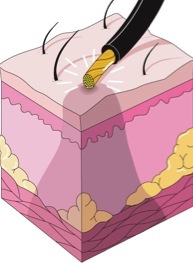-
Emergency Conditions / First Aid





Electric Shock
Electric shock occurs when an electric current flows through the body. The human body is made up of 60% to 70% water. This makes it a good conductor of electricity. Burns, damage to internal organs, heart rhythm problems, and death can result from electric shock.

Signs & Symptoms
-
•Shocking sensations. Numbness or tingling. A change in vision, speech, or in any sensation.
-
•Burns or open wounds. These occur where the electricity enters and exits the body.
-
•Muscle spasms or contractions.
-
•Sudden immobility or fractures. A body part may look deformed.
-
•Interrupted breathing. Irregular heartbeats or chest pain.
-
•Seizures.
-
•Unconsciousness.
A small child who bites or sucks on an electric cord can have a facial injury or distinct burn around the rim of the mouth.
Electric Shock can cause tissue damage under the skin’s surface.
Causes
-
•Touching a high-voltage (more than 1,000 volts) source, such as high-tension wires that fall during a storm. Touching someone who is still touching a live current. Touching a low-voltage (less than 1,000 volts) current source, such as an electric socket or worn cord.
-
•Mixing water and electricity.
-
•Being struck by lightning. A bolt of lightning carries as many as 30 million volts.
Treatment
Contact with electricity from a high-voltage wire or being struck by lightning needs emergency medical care. Contact with electricity from a low-voltage current needs emergency medical care if any signs or symptoms listed above are present. A person who does not have any symptoms should still see a doctor to check for possible internal injuries.
To Avoid Being Harmed by Lightning
-
•Heed weather warnings.
-
•Take shelter in a building, if you can.
-
•Stay in your car (if it is not a convertible) rather than out in the open.
-
•If you are caught outside, avoid tall trees, open water, metal objects, and high ground. Crawl into a low-lying place or curl up on the ground, head to knees with your head touching the ground.
(Note: Give first aid for burns as needed. See below)







Heed warnings to avoid electrical hazards.
Prevention
-
•Stay clear of fallen wires. Inform the police, electric company, etc.
-
•Install ground-fault circuit-interrupters (GFCIs) in wall outlets of bathrooms, kitchens, etc. With GFCIs, when an electrical appliance falls into water, the current is instantly cut off.
-
•Don’t turn electrical switches on or off or touch an electric appliance while your hands are wet, while standing in water, or when sitting in a bathtub.
-
•Replace worn cords and wiring.
-
•Cover all electric sockets with plastic safety caps.
-
•Before you do electrical repairs, remove the fuse from the fuse box or switch off the circuit breaker. Don’t just turn off the appliance or light switch.
Self-Care / First Aid
Beware! Do not put yourself in danger to give first aid. Do not touch the
person until power is shut off.
-
•If the source is a high-voltage wire or lightning, call 9-1-1!
-
•It is safe to touch a person struck by lightning.
-
•If the source is a low-voltage current, remove the fuse or switch off the circuit breaker to the electrical outlet.
-
•If you can’t shut off the source, with dry feet and hands, use a board, wooden stick, rope, etc. to get the person away from the source.
-
•If it is safe for you to touch the person, check for a response. (See Step 2 in First Aid Precautions.) Give CPR, as needed.
-
-Unless it is absolutely necessary, don’t move the person. He or she could have a traumatic injury, especially to the head or neck.
-
-Check for burns. Cover burned areas with dry, sterile dressings.
-
-Give first aid for Shock, if needed.
After having an electric shock, are any of these problems present?
-
•Cough with phlegm. Fever. Headache.
-
•Wounds are not healing.
-
•Tetanus shots are not up-to-date.
Has an electric shock gone through the body in such a way that it might have passed through the center of the chest? Or, are any signs and symptoms of electric shock listed above present?
Do any of these problems occur?
-
•The person is still in contact with the electric source or was in contact with a high-voltage wire.
-
•The person was struck by lightning.
-
•The person is not breathing.
Questions to Ask





Copyright © 2009, American Institute for Preventive Medicine. All rights reserved.